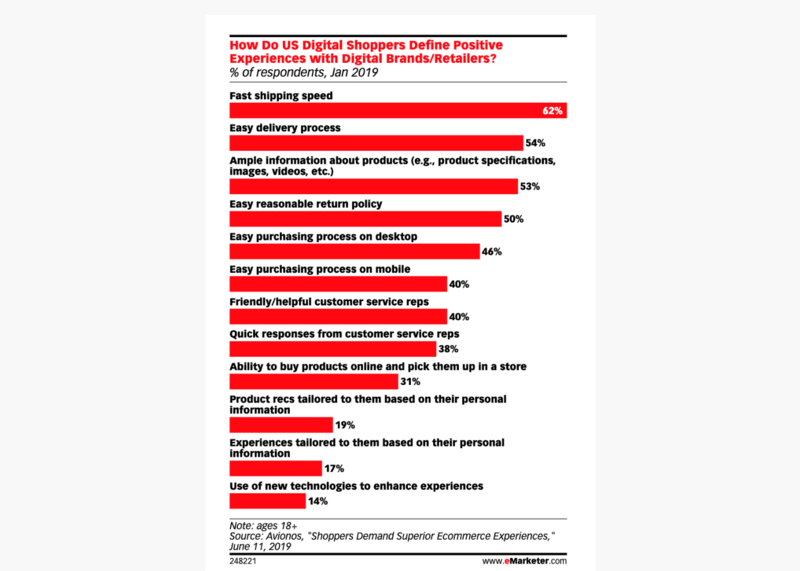Top Delivery Speed Is More Attainable Than You Think
758
0
·
2020/07/13
·
4 mins read
☕
WriterShelf™ is a unique multiple pen name blogging and forum platform. Protect relationships and your privacy. Take your writing in new directions. ** Join WriterShelf**
WriterShelf™ is an open writing platform. The views, information and opinions in this article are those of the author.
Article info
Categories:
⟩
⟩
Date:
Published: 2020/07/13 - Updated: 2020/07/13
Total: 977 words
Like
or Dislike
More from this author
More to explore











Speed of Delivery Is Affecting Your Business
Delivery speed is important for businesses of all sizes, but don’t take our word for it. These statistics clearly illustrate the importance of fast delivery to customers:
62% of consumers say fast shipping speed defines a positive experience (eMarketer)
61% of consumers want their orders delivered faster (retail Touch Points)
Over 75% of consumers want same-day shipping (efulfillment service)
55% of consumers will switch retailers for faster delivery (Capgemini)
More than 98% of shoppers say delivery affects how loyal they are to a brand (Convey)
Customers don’t see fast shipping options as a perk—they see it as a requirement. The most successful ecommerce stores are capitalizing on this. Amazon is raising the bar for their Prime members from guaranteed two-day shipping to just one-day shipping, and Walmart is offering free NextDay delivery to online shoppers without charging a membership fee. Smart businesses of all sizes are using fast shipping to attract more buyers during busy holiday shopping seasons.
If you want to compete in today’s industry, you’re going to need a bulletproof strategy and robust technology.
5 Strategies for Faster Deliveries
There are five proven strategies you can use to speed up delivery, and route optimization software is your secret weapon for executing all of them successfully. OptimoRoute was designed to help you do all of the following in a fraction of the time.
1. Optimize delivery routes
If you want to reach top delivery speeds, the first thing you must do is optimize your routing. Optimizing delivery routes means selecting the fastest, most cost-effective routes possible.
It’s difficult to achieve truly optimized routes if you’re relying on manual calculations and basic mapping software. If you have a fleet of more than a couple of vehicles or need to deliver hundreds of orders a day, optimizing routes becomes nearly impossible (and takes a ton of time). This is where route optimization software comes in.
2. Plan ahead
Advance planning and scheduling are essential if you want to shorten your delivery times, because the farther out you plan, the better your execution will be. If you’re planning deliveries only one week in advance, you leave yourself with a very tight window to make necessary changes, and you’re more likely to be caught off guard.
Let’s say you get an influx of orders for the holidays that starts two weeks earlier than usual. If you’re planning five weeks in advance, you’ll spot this uptick with plenty of time to schedule additional drivers and successfully meet demand. If you’re only planning five business days in advance, you may not have enough time to react accordingly, which could cost you customers.
OptimoRoute’s advance-planning capabilities help businesses like The Little Posy Co., a flower company in Australia, keep deliveries running smoothly even when their demand increases by 400% around holidays such as Valentine’s Day. The Little Posy Co. is able to scale their fleet up from 20 to 60 drivers quickly and efficiently, so they can capitalize on a rise in holiday demand.
Scheduling drivers further in advance creates a healthier (and more productive) working environment, too. Drivers who know their schedule a month in advance have time to find coverage or request a shift swap, so they can be home for important family events. Promoting a healthy work–life balance fosters happier workers, who are more engaged and productive at work — which means higher on-time delivery rates and increased revenue.
3. Enable real-time route modification
Advance planning is important, but so is the ability to change that plan when unexpected challenges arise. Every adventure has a few surprises, and delivery routes are no different. Drivers may run into traffic, get held up at a delivery helping a customer, or get a flat tire. To keep small hold-ups from turning into hours-long delays, dispatchers need to know immediately when things don’t go as expected.
4. Prioritize appropriately
Prioritizing and ordering stops appropriately ensures that you reach all of your customers as quickly (and efficiently) as possible. Accurately setting priorities for stops along your delivery route is vital, and there are a lot of factors to consider. If a customer pays extra for next-day delivery, that order is going to be a higher priority than a package purchased with standard delivery. On the flip side, if the rush order customer is five miles away, and there are three standard delivery orders on the route there, it will make sense to stop and drop off those non-rush orders first.
You’ll also need to consider how orders are assigned across multiple drivers. Territories that are evenly divided, as far as square footage per driver, may result in completely uneven workloads. You can wind up with one driver working overtime to barely meet delivery deadlines and another driver sitting around for half of their shift with nothing to do. On top of that, some stops may require drivers with a specific skill set, particularly if you offer installation along with your deliveries.
Achieving the highest overall delivery speed across your entire team takes a lot more thought than simply dividing up the map and having drivers work their way across the board. It requires a full-spectrum approach, along with software that can adapt to your unique business. OptimoRoute gives fleet managers the power to prioritize routing for the lowest cost, evenly distributed workloads, or a combination of the two. You can adjust routes to meet your priorities, even if those priorities change from week to week.
5. Combine forward and reverse logisticsCombining reverse logistics pick-up routes with forward logistics drop-off routes cuts your travel time and your planning time in half. If you already have a delivery driver going to a certain area to drop off products, it doesn’t make sense to send another driver to a nearby destination to pick something up.
This article originally appeared on optimoroute.com.